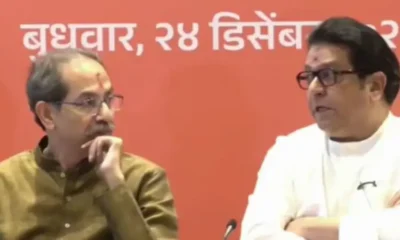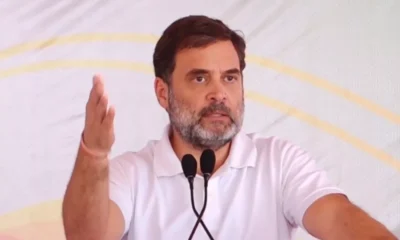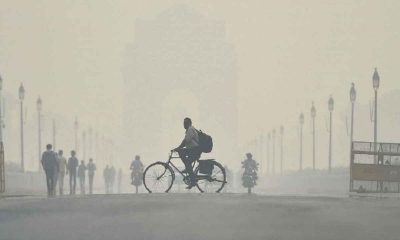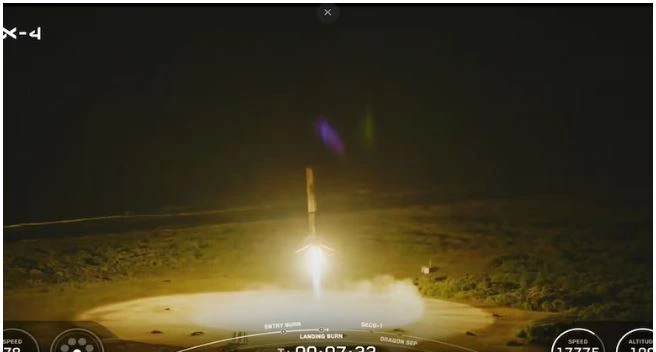[vc_row][vc_column][vc_column_text]
A tweet from the Army last night (Monday, April 29) that its team had sighted “mysterious footprints of the mythical beast Yeti”, also called the “abominable snowman” went viral, evoking reactions from all over.
The army, sharing images on its official Twitter handle, said a mountaineering expedition team had found the Yeti’s “mysterious footprints measuring 32X15 inches”. The tweet was meant to “excite scientific temper,” the army said as the Yeti claim led to questions and disbelief.
The army said it discovered the footprints on April 9 at Makalu Base Camp in Nepal. It also claimed that the “elusive snowman” has also only been sighted nearby at Makalu-Barun National Park.
In the images, the prints appear to be of a single foot.[/vc_column_text][/vc_column][/vc_row][vc_row][vc_column][vc_raw_html]JTNDYmxvY2txdW90ZSUyMGNsYXNzJTNEJTIydHdpdHRlci10d2VldCUyMiUyMGRhdGEtbGFuZyUzRCUyMmVuJTIyJTNFJTNDcCUyMGxhbmclM0QlMjJlbiUyMiUyMGRpciUzRCUyMmx0ciUyMiUzRUZvciUyMHRoZSUyMGZpcnN0JTIwdGltZSUyQyUyMGFuJTIwJTNDYSUyMGhyZWYlM0QlMjJodHRwcyUzQSUyRiUyRnR3aXR0ZXIuY29tJTJGaGFzaHRhZyUyRkluZGlhbkFybXklM0ZzcmMlM0RoYXNoJTI2YW1wJTNCcmVmX3NyYyUzRHR3c3JjJTI1NUV0ZnclMjIlM0UlMjNJbmRpYW5Bcm15JTNDJTJGYSUzRSUyME1vdXRhaW5lZXJpbmclMjBFeHBlZGl0aW9uJTIwVGVhbSUyMGhhcyUyMHNpdGVkJTIwTXlzdGVyaW91cyUyMEZvb3RwcmludHMlMjBvZiUyMG15dGhpY2FsJTIwYmVhc3QlMjAlMjYlMjMzOSUzQllldGklMjYlMjMzOSUzQiUyMG1lYXN1cmluZyUyMDMyeDE1JTIwaW5jaGVzJTIwY2xvc2UlMjB0byUyME1ha2FsdSUyMEJhc2UlMjBDYW1wJTIwb24lMjAwOSUyMEFwcmlsJTIwMjAxOS4lMjBUaGlzJTIwZWx1c2l2ZSUyMHNub3dtYW4lMjBoYXMlMjBvbmx5JTIwYmVlbiUyMHNpZ2h0ZWQlMjBhdCUyME1ha2FsdS1CYXJ1biUyME5hdGlvbmFsJTIwUGFyayUyMGluJTIwdGhlJTIwcGFzdC4lMjAlM0NhJTIwaHJlZiUzRCUyMmh0dHBzJTNBJTJGJTJGdC5jbyUyRkFNRDRNWUlnVjclMjIlM0VwaWMudHdpdHRlci5jb20lMkZBTUQ0TVlJZ1Y3JTNDJTJGYSUzRSUzQyUyRnAlM0UlMjZtZGFzaCUzQiUyMEFERyUyMFBJJTIwLSUyMElORElBTiUyMEFSTVklMjAlMjglNDBhZGdwaSUyOSUyMCUzQ2ElMjBocmVmJTNEJTIyaHR0cHMlM0ElMkYlMkZ0d2l0dGVyLmNvbSUyRmFkZ3BpJTJGc3RhdHVzJTJGMTEyMjkxMTc0ODgyOTI3MDAxNiUzRnJlZl9zcmMlM0R0d3NyYyUyNTVFdGZ3JTIyJTNFQXByaWwlMjAyOSUyQyUyMDIwMTklM0MlMkZhJTNFJTNDJTJGYmxvY2txdW90ZSUzRSUwQSUzQ3NjcmlwdCUyMGFzeW5jJTIwc3JjJTNEJTIyaHR0cHMlM0ElMkYlMkZwbGF0Zm9ybS50d2l0dGVyLmNvbSUyRndpZGdldHMuanMlMjIlMjBjaGFyc2V0JTNEJTIydXRmLTglMjIlM0UlM0MlMkZzY3JpcHQlM0UlMEE=[/vc_raw_html][/vc_column][/vc_row][vc_row][vc_column][vc_column_text]Media reports quoting army sources said the story is based on “physical proof of on-the-spot narration”, photos and videos. “We got the inputs about 10 days back and yet we held on to it,” they said, promising that the “photos and videos may surprise you”.
The photographic evidence matches earlier theories, the army claims.
“We tweeted as we thought prudent to excite scientific temper and rekindle the interest. Some of us who reject the story surely shall have a definite answer to the evidences. As they say nature, history and science never write their final story,” media reports quoting sources said.
There have been many stories about the mystery of the “The Abominable Snowman”, mostly based on unconfirmed, often fantastical accounts of its giant size and terrifying howl.
The yeti also features in traditional Nepalese folklore, in which it is described as furry and ape-like. A very popular Tintin episode, “Tintin in Tibet”, borrowed that version.
Many have in the past claimed to debunk such sightings, saying what was seen was in fact, a bear. One such report published in 2017 claimed that the creature sighted could have been three different kinds of bears: the Asian black bear, the Tibetan brown bear and the Himalayan brown bear.
“Our findings strongly suggest that the biological underpinnings of the Yeti legend can be found in local bears,” said lead scientist Charlotte Lindqvist, associate professor at the University of Buffalo College of Arts and Sciences, reported NDTV.
The study also collected genetic evidence from bone, tooth, skin, hair and fecal samples, which were linked to the Yeti. Artefacts gathered from private collections and museums across the world include a monastic relic said to come from a Yeti paw. In reality, the relic turned out to be the remains of 23 distinct bears, the NDTV report said.
In 2011, DNA tests on a “yeti finger” taken from Nepal to London half a century ago found it to be human bone, a BBC report said, adding, that in 2013, DNA tests on hair samples carried out by Oxford University genetics professor Bryan Sykes found that they matched those from an ancient polar bear. He said the most likely explanation for the myth is that the animal is a hybrid of polar bears and brown bears.
The Army’s tweet also evoked some mirth and trolling by twitterati. One mocked at the PM Narendra Modi and his party BJP’s penchant for branding every questioning of authority and army as anti-national:
Meghnad @Memeghnad: “If you question Indian Army’s ‘Yeti’ discovery, are you anti-national?”
In the same vein, Actor Siddharth said: “It’s shameful that people are asking the army for proof. #Yeti #MythicalYeti #BelieveTheMyth”
A more direct jibe came from documentary film maker Rakesh Sharma @rakeshfilm:
“Why not ask the man who spent many mysterious, solitary years in the Himalayas – PM Modi? We’re anyway blessed to have a leader who knows everything about everything – climate change, transplant surgery, monetary policy, missiles, mythology, history, mangoes, crocodiles. #Yeti”[/vc_column_text][/vc_column][/vc_row][vc_row][vc_column][vc_raw_html]JTNDYmxvY2txdW90ZSUyMGNsYXNzJTNEJTIydHdpdHRlci10d2VldCUyMiUyMGRhdGEtbGFuZyUzRCUyMmVuJTIyJTNFJTNDcCUyMGxhbmclM0QlMjJlbiUyMiUyMGRpciUzRCUyMmx0ciUyMiUzRVdoeSUyMG5vdCUyMGFzayUyMHRoZSUyMG1hbiUyMHdobyUyMHNwZW50JTIwbWFueSUyMG15c3RlcmlvdXMlMkMlMjBzb2xpdGFyeSUyMHllYXJzJTIwaW4lMjB0aGUlMjBIaW1hbGF5YXMlMjAtJTIwUE0lMjBNb2RpJTNGJTNDYnIlM0UlM0NiciUzRVdlJUUyJTgwJTk5cmUlMjBhbnl3YXklMjBibGVzc2VkJTIwdG8lMjBoYXZlJTIwYSUyMGxlYWRlciUyMHdobyUyMGtub3dzJTIwZXZlcnl0aGluZyUyMGFib3V0JTIwZXZlcnl0aGluZyUyMC0lMjBjbGltYXRlJTIwY2hhbmdlJTJDJTIwdHJhbnNwbGFudCUyMHN1cmdlcnklMkMlMjBtb25ldGFyeSUyMHBvbGljeSUyQyUyMG1pc3NpbGVzJTJDJTIwbXl0aG9sb2d5JTJDJTIwaGlzdG9yeSUyQyUyMG1hbmdvZXMlMkMlMjBjcm9jb2RpbGVzLiUyMCUzQ2ElMjBocmVmJTNEJTIyaHR0cHMlM0ElMkYlMkZ0d2l0dGVyLmNvbSUyRmhhc2h0YWclMkZZZXRpJTNGc3JjJTNEaGFzaCUyNmFtcCUzQnJlZl9zcmMlM0R0d3NyYyUyNTVFdGZ3JTIyJTNFJTIzWWV0aSUzQyUyRmElM0UlMjAlM0NhJTIwaHJlZiUzRCUyMmh0dHBzJTNBJTJGJTJGdC5jbyUyRmNxRGhHeENibTIlMjIlM0VodHRwcyUzQSUyRiUyRnQuY28lMkZjcURoR3hDYm0yJTNDJTJGYSUzRSUzQyUyRnAlM0UlMjZtZGFzaCUzQiUyMFJha2VzaCUyMFNoYXJtYSUyMCUyOCU0MHJha2VzaGZpbG0lMjklMjAlM0NhJTIwaHJlZiUzRCUyMmh0dHBzJTNBJTJGJTJGdHdpdHRlci5jb20lMkZyYWtlc2hmaWxtJTJGc3RhdHVzJTJGMTEyMzA5NTE0NTA1Njg3ODU5MiUzRnJlZl9zcmMlM0R0d3NyYyUyNTVFdGZ3JTIyJTNFQXByaWwlMjAzMCUyQyUyMDIwMTklM0MlMkZhJTNFJTNDJTJGYmxvY2txdW90ZSUzRSUwQSUzQ3NjcmlwdCUyMGFzeW5jJTIwc3JjJTNEJTIyaHR0cHMlM0ElMkYlMkZwbGF0Zm9ybS50d2l0dGVyLmNvbSUyRndpZGdldHMuanMlMjIlMjBjaGFyc2V0JTNEJTIydXRmLTglMjIlM0UlM0MlMkZzY3JpcHQlM0UlMEE=[/vc_raw_html][/vc_column][/vc_row]


 India News17 hours ago
India News17 hours ago
 Latest world news17 hours ago
Latest world news17 hours ago
 India News10 hours ago
India News10 hours ago
 India News13 hours ago
India News13 hours ago
 India News13 hours ago
India News13 hours ago
 India News17 hours ago
India News17 hours ago
 India News9 hours ago
India News9 hours ago
 India News8 hours ago
India News8 hours ago















